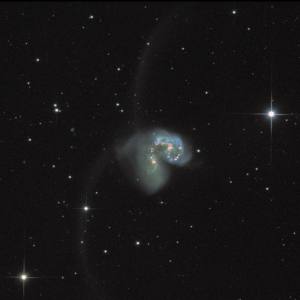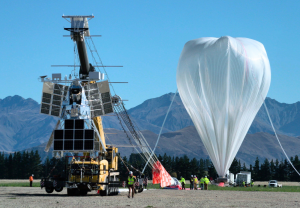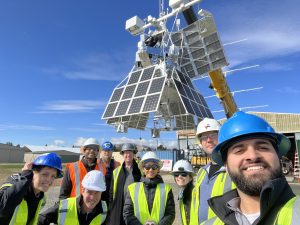By Leighton Kitson, Durham University, with notes from Meaghan MacSween, Dunlap Institute for Astronomy and Astrophysics, University of Toronto

A false-colour image taken by the SuperBIT telescope soon after launch in visible and ultra-violet light of the “Tarantula Nebula” – a bright cluster of gas and dust in a galaxy neighbourhood near our Milky Way, where new stars are being born. Credit: SuperBIT.
Astronomers have successfully launched a balloon-borne telescope that has begun capturing images of the Universe on its first flight above the Earth’s atmosphere.
The Super Pressure Balloon-Borne Imaging Telescope (SuperBIT) was flown to the edge of space by a helium-filled NASA scientific balloon the size of a football stadium, where it will help researchers investigate the mystery of dark matter.
SuperBIT has already taken its first images on this flight, showing the “Tarantula Nebula” – a bright cluster of gas and dust in a galaxy neighbourhood near our Milky Way, and the collision between the two galaxies NGC 4038 and NGC 4039 known as “the Antennae.”
SuperBIT is a collaboration between Durham University, UK, the University of Toronto, Canada, Princeton University, USA, NASA, and the Canadian Space Agency.
It launched from Wānaka, Aotearoa New Zealand earlier this week, following a two-year delay due to the COVID pandemic.
Carried by seasonally stable winds for about three months, SuperBIT will circumnavigate the southern hemisphere several times – imaging the sky all night, then using solar panels to recharge its batteries during the day.
SuperBIT flies at an altitude of 33.5km, above 99.5 per cent of the Earth’s atmosphere. It takes high-resolution images like those from the Hubble Space Telescope, but with a much wider field of view.

A false-colour image taken by the SuperBIT telescope soon after launch in visible and ultra-violet light of a pair of galaxies smashing into each other. As they collide, the “Antennae galaxies” NGC 4038 and NGC 4039 are ripping strips off each other and opening themselves for inspection. Credit: SuperBIT.
The science goal for this first flight is to measure the properties of dark matter, a heavy but invisible type of material. Dark matter is all around us but poorly understood.
SuperBIT will test whether dark matter particles can bounce off each other, by mapping the dark matter around clusters of galaxies that are colliding with neighbouring galaxy clusters.
Various theories about dark matter suggest that, during a collision, some dark matter might either slow down, spread out, or get chipped off.
The researchers say that if they can map dark matter leaving the collision, they could finally start to learn what it is made of.
“A dedicated team of students developing one of the world’s great telescopes – it’s inspiring,” says Barth Netterfield, a Professor at the David A. Dunlap Department of Astronomy and Astrophysics and Department of Physics at the University of Toronto, and an Associate at the Dunlap Institute for Astronomy and Astrophysics. “And now, after a decade of tremendous effort, we are getting these exquisite images with a wide range of science goals, which will help us to better understand the Universe.”
Although dark matter is invisible, SuperBIT will map where it is by the way it bends passing rays of light, a technique known as gravitational lensing.
While telescopes on the ground must squint through the Earth’s atmosphere – meaning their view can become blurred – space-based telescopes get a clear view of the light that has travelled billions of years from the distant universe.
SuperBIT is the first ever balloon-borne telescope capable of taking wide-field images: its sharpness of vision is not affected by the atmosphere, but only by the laws of optics.
During its final test flight in 2019, SuperBIT demonstrated extraordinary pointing stability. “Imagine you’re trying to thread a needle that’s 2.5 km away (so roughly 30 city blocks),” explains Emaad Paracha, PhD candidate at the Department of Physics, University of Toronto. “SuperBIT has the ability to point to the exact spot you’d need that needle to be thread, while keeping that thread from touching the sides of the needle for up to 60 minutes.”
SuperBIT cost about $5 million USD – almost 1,000 times less than an equivalent satellite. Not only is helium cheaper than rocket fuel, but the ability of SuperBIT to return to Earth via parachute meant the team could tweak its design over several test flights.
“A successful SuperBIT launch paves the way to a future in which individual academic institutions are able to design, develop, and operate world-class space instruments at a low cost, while also providing the training opportunity for instrument development and data analysis for the students,” says Ajay Gill, a PhD candidate at the David A. Dunlap Department of Astronomy and Astrophysics and the Dunlap Institute.
SuperBIT can also be upgraded relatively easily on a regular basis. For example, the development team buys a new camera shortly before each launch, because modern detectors are improving so rapidly. Using cutting-edge technology has kept SuperBIT young.
The team already has funding to upgrade SuperBIT’s 0.5-metre wide telescope to 1.6 metres, which would boost light gathering power tenfold, with a wider-angle lens and more megapixels. The relatively cheap cost may even make it possible for a fleet of balloon-borne telescopes to offer time to astronomers around the world.
________________________________________________________________________________________
You can follow SuperBIT’s flight status on NASA’s website here. Video of SuperBIT’s launch can be found here (Video credit: NASA; Bill Rodman).
Funding for the SuperBIT mission has been provided by NASA, the Canadian Space Agency, the Royal Society, and the Dunlap Institute for Astronomy and Astrophysics.
About NASA’s Scientific Balloon program
NASA’s Scientific Balloon program, managed from the Agency’s Wallops Flight Facility, flies about a dozen balloon missions annually from the United States and worldwide locations, such as New Zealand, Sweden, and Antarctica. The program supports scientific investigations largely in the field of Astrophysics along with supporting technology development and student flight opportunities.
For more information, please contact:
Meaghan MacSween
Communications and Multimedia Officer
Dunlap Institute for Astronomy & Astrophysics,
University of Toronto
meaghan.macsween@utoronto.ca


